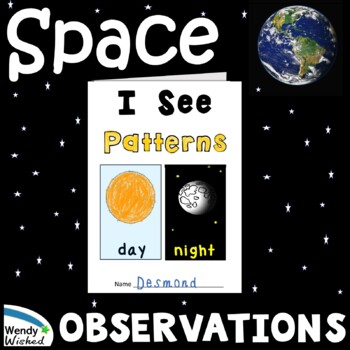Patterns in the Sky Sun Earth Outer Space and Moon Phases 1st Grade Science
- PDF
What educators are saying
Description
Use these activities to teach your students to make observations of the sun, moon, and stars to describe patterns in the sky which can be predicted as targeted by NGSS™. Your first grade students will learn about Earth's place in the universe and the patterns (and cycles) all around us. Get a book and writing activities that focus on vocabulary related to the movement of the sun, moon, and Earth . Your students will be engaged and you won't stress when you have everything you need to teach your lesson. Just download this resource.
Click on the green "VIEW PREVIEW" button above to see what is included in this resource.
Included in your download:
● 2 pages of Teacher Tips that include lesson plan suggestions and sequence of activities
● I See Patterns book.
- Concepts covered: day and night, the shape of the moon, up in the night sky (stars and constellations), sunrise and sunset, seasons, year, patterns
- Words in the glossary: day, revolve, rotate, year
● Writing pages: two types of writing lines provided
● 6 Definition cards: orbit, revolve, rotate, tilt, pattern, phases of the moon
● Venn diagram
● Label and color page
● Illustrate the vocabulary worksheet
● Die inserts and chart for data collection game
Get EVERYTHING for a unit on Earth's Place in the Universe when you get these too:
Mark off the standard as complete! ‘Use observations of the sun, moon, and stars to describe patterns that can be predicted’ (NGSS).
Have fun teaching science this year.
If you have wished for a resource, you might find it in my store - Wendy Wished
Please leave a review after you use these materials. I want to hear how it went and other teachers will too! Thanks.
★☆★☆★☆★☆★☆★☆★☆★☆★☆★☆★☆★☆★☆★☆★☆★☆★☆★☆★☆★☆★☆★☆★☆★☆★☆★☆★☆★
Follow My Store: Save 50% the first few days on new resources and get a freebie from me now and then. Let me make teaching easier for you. (Just click the green link.)
See how much these make your life easier and come back for these NGSS resources as well:
★☆★☆★☆★☆★☆★☆★☆★☆★☆★☆★☆★☆★☆★☆★☆★☆★☆★☆★☆★☆★☆★☆★☆★☆★☆★☆★☆★
Your purchase grants you permission for single classroom and personal use only.
Give a REVIEW and get FREE TPT Credits:
- Go to your “My Purchases” & just comment with a “Review”. Then save money on your next TpT purchase.
★☆★☆★☆★☆★☆★☆★☆★☆★☆★☆★☆★☆★☆★☆★☆★☆★☆★☆★☆★☆★☆★☆★☆★☆★☆★☆★☆★☆
© Copyright Wendy Wished. All rights reserved by author. This product is to be used by the original purchaser only. Copying for more than one teacher or classroom, or for an entire grade level, team, school, or school system is prohibited. This product may not be distributed or displayed digitally for public view, uploaded to school or district websites, distributed via email, or submitted to file sharing sites. Failure to comply is a copyright infringement and a violation of the Digital Millennium Copyright Act (DMCA).
Next Generation Science Standards (“NGSS”) is a registered trademark of Achieve. Neither Achieve nor the lead states and partners that developed the Next Generation Science Standards were involved in the production of this product, and do not endorse it.





